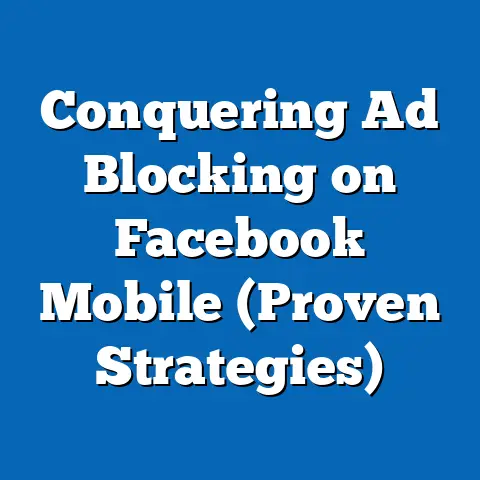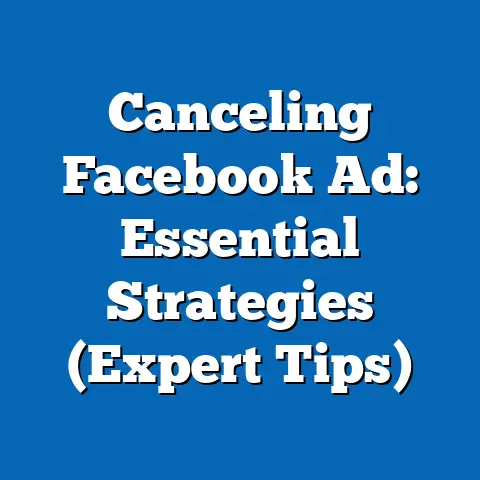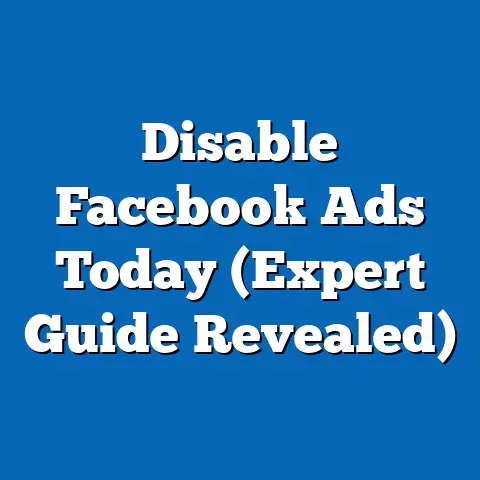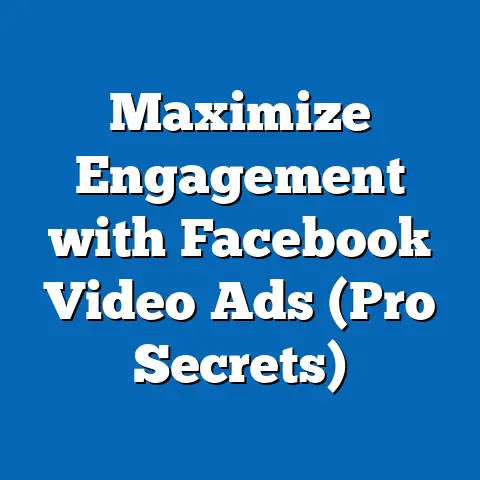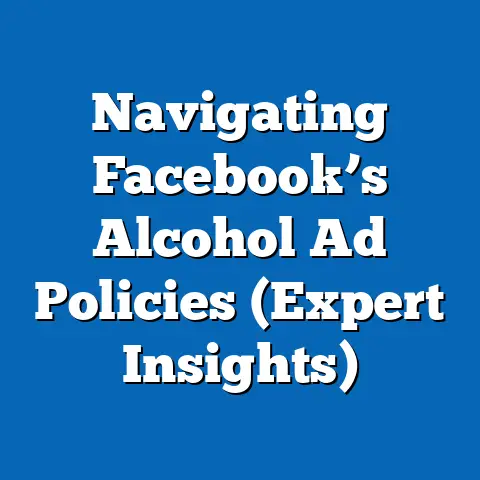Master Facebook Ad Forecasting (Uncover Winning Strategies)
I’ve seen it countless times – businesses launching Facebook ad campaigns with a mix of hope and a hefty dose of uncertainty. They pour their resources into creative ads and meticulously defined audiences, only to be left wondering if their investment will truly pay off. According to recent studies, businesses that utilize advanced forecasting techniques for their Facebook ad campaigns see an increase in ROI by up to 30%. That’s a significant jump, and it highlights the power of knowing what to expect before you spend a dime.
Understanding Facebook Ad Forecasting
Before diving into the nitty-gritty, let’s establish a solid foundation. What exactly is Facebook ad forecasting, and why should you care?
Defining Facebook Ad Forecasting
Facebook ad forecasting is the process of predicting the future performance of your Facebook advertising campaigns. It involves analyzing historical data, current trends, and various campaign parameters to estimate key metrics like reach, impressions, clicks, conversions, and ultimately, return on ad spend (ROAS).
Think of it like weather forecasting. Meteorologists use data points like temperature, wind speed, and humidity to predict the likelihood of rain. Similarly, in ad forecasting, we use data points like past campaign performance, target audience size, and budget to predict how our future campaigns will perform.
Why Forecasting Matters: More Than Just Guesswork
Forecasting isn’t just about crystal-ball gazing; it’s a critical component of a successful digital marketing strategy for several reasons:
- Budget Optimization: Knowing what to expect allows you to allocate your budget more effectively. You can identify which campaigns are likely to deliver the best results and allocate more resources to those areas. This prevents wasted ad spend on campaigns that are unlikely to perform well.
- Targeting Refinement: Forecasting can help you identify the most responsive segments within your target audience. By analyzing historical data, you can pinpoint demographics, interests, and behaviors that drive the most conversions, allowing you to refine your targeting and improve ad relevance.
- Creative Optimization: Understanding predicted performance allows you to test different ad creatives and identify which resonate best with your audience. By analyzing metrics like click-through rate (CTR) and conversion rate, you can optimize your ad copy, visuals, and calls to action for maximum impact.
- Risk Mitigation: Forecasting helps you identify potential risks and challenges before they impact your campaign. By understanding potential fluctuations in performance, you can proactively adjust your strategy to mitigate those risks and ensure your campaigns stay on track.
- Improved ROI: Ultimately, the goal of forecasting is to improve your return on investment (ROI). By optimizing your budget, targeting, and creative based on predicted performance, you can maximize the value you get from your Facebook advertising campaigns.
Key Metrics for Forecasting Success
To effectively forecast your Facebook ad performance, you need to understand the key metrics that drive results. Here are some of the most important ones:
- Cost Per Click (CPC): The amount you pay each time someone clicks on your ad. Lower CPC generally indicates more efficient ad spending.
- Click-Through Rate (CTR): The percentage of people who see your ad and click on it. A high CTR suggests your ad is relevant and engaging to your target audience.
- Conversion Rate: The percentage of people who click on your ad and then complete a desired action, such as making a purchase or filling out a form. A high conversion rate indicates that your landing page and offer are compelling.
- Customer Acquisition Cost (CAC): The total cost of acquiring a new customer through your Facebook ads. Lower CAC means you’re acquiring customers more efficiently.
- Return on Ad Spend (ROAS): The revenue you generate for every dollar you spend on Facebook advertising. A high ROAS indicates that your campaigns are profitable.
- Impressions: The number of times your ad is displayed. This reflects your ad’s reach and visibility.
- Reach: The number of unique individuals who saw your ad. This metric helps you understand the scale of your audience.
- Frequency: The average number of times each person saw your ad. Monitoring frequency is crucial to avoid ad fatigue.
Takeaway: Facebook ad forecasting is a powerful tool that can help you optimize your campaigns, improve your ROI, and achieve your business goals. By understanding the key metrics and implementing effective forecasting strategies, you can take control of your Facebook advertising and drive real results.
Analyzing Historical Data: The Foundation of Accurate Predictions
The best predictor of future behavior is past behavior. This holds true for Facebook ads as well. Analyzing your historical data is the crucial first step in building an accurate forecasting model.
Data Sources: Where to Find Your Goldmine
Fortunately, Facebook provides a wealth of data within its platform. Here are the primary sources you should be tapping into:
- Facebook Ads Manager: This is your central hub for everything related to your Facebook ad campaigns. Within Ads Manager, you can access detailed reports on campaign performance, ad set performance, and individual ad performance. You can filter data by date range, demographics, placements, and other variables to gain valuable insights.
- Facebook Analytics (Now Meta Analytics): While Facebook Analytics is being phased out, you may still have access to historical data. This tool provides insights into user behavior on your website and app, allowing you to track conversions, engagement, and other key metrics.
- Google Analytics: If you’ve integrated Google Analytics with your Facebook ads, you can track the performance of your campaigns in terms of website traffic, conversions, and revenue. This provides a broader perspective on the impact of your Facebook ads on your overall business.
- CRM Systems: If you’re using a CRM system like Salesforce or HubSpot, you can track the lifetime value of customers acquired through Facebook ads. This allows you to assess the long-term ROI of your campaigns.
- Spreadsheets: I know, it sounds basic, but a well-organized spreadsheet is essential for compiling, analyzing, and visualizing your data. You can import data from various sources into a spreadsheet and use formulas and charts to identify trends and patterns.
Trend Identification: Unveiling the Secrets in the Numbers
Once you’ve gathered your data, it’s time to start looking for trends. Here are some common patterns to watch out for:
- Seasonal Fluctuations: Do your sales tend to spike during certain times of the year, like holidays or back-to-school season? If so, you’ll need to adjust your forecasting model to account for these seasonal trends.
- Day of Week/Time of Day Performance: Are your ads more effective on certain days of the week or at certain times of the day? Analyzing this data can help you optimize your ad scheduling for maximum impact.
- Audience Performance: Which segments of your target audience are most responsive to your ads? By analyzing demographics, interests, and behaviors, you can identify your most valuable customer segments and tailor your messaging accordingly.
- Ad Creative Performance: Which ad creatives are generating the highest CTR and conversion rates? By analyzing the performance of different ad variations, you can identify the most effective ad copy, visuals, and calls to action.
- Placement Performance: Are your ads performing better on Facebook’s News Feed, Instagram, or Audience Network? Analyzing placement performance can help you optimize your ad placements for maximum reach and engagement.
- Campaign-Specific Trends: Look for trends specific to particular campaigns. Did a specific offer generate a surge in sales? Did a new ad format perform exceptionally well? Identify these campaign-specific trends and incorporate them into your forecasting model.
Example: Let’s say you’re running an e-commerce store that sells outdoor gear. You analyze your historical data and discover that sales tend to spike during the summer months, particularly in June and July. You also notice that ads targeting outdoor enthusiasts in specific geographic regions (e.g., the Pacific Northwest) tend to perform better than ads targeting a broader audience. Finally, you find that ads featuring high-quality images of your products in action generate the highest CTRs.
Case Studies: Learning from Success (and Failure)
Analyzing case studies of successful Facebook ad campaigns can provide valuable insights into effective forecasting strategies. Look for case studies that are relevant to your industry and business model.
Example: A case study might highlight how a clothing retailer used historical data to predict a surge in demand for specific clothing items during a flash sale. By accurately forecasting demand, the retailer was able to optimize its inventory levels and ensure that it had enough product to meet customer demand. This resulted in a significant increase in sales and a higher ROI on its Facebook ad spend.
Takeaway: Historical data is your most valuable asset when it comes to Facebook ad forecasting. By analyzing your past performance, you can identify trends, optimize your campaigns, and improve your ROI. Don’t underestimate the power of data!
Utilizing Facebook’s Predictive Tools: A Helping Hand
While analyzing historical data is essential, Facebook also offers its own set of predictive tools that can help you forecast campaign performance. These tools leverage Facebook’s vast data resources and machine learning algorithms to provide insights into audience behavior, budget recommendations, and performance predictions.
Facebook Insights: Understanding Your Audience
Facebook Insights (now Meta Business Suite Insights) provides valuable data about your audience, including demographics, interests, behaviors, and engagement metrics. This information can be used to refine your targeting and improve ad relevance.
- Audience Demographics: Insights provides data on the age, gender, location, and language of your audience. This can help you ensure that you’re targeting the right people with your ads.
- Interests: Insights provides data on the interests and hobbies of your audience. This can help you identify relevant targeting options and create ads that resonate with your audience.
- Behaviors: Insights provides data on the online and offline behaviors of your audience, such as purchase history, device usage, and travel patterns. This can help you create highly targeted ads that are relevant to your audience’s specific needs and interests.
- Engagement Metrics: Insights provides data on how your audience is engaging with your content, such as likes, comments, shares, and clicks. This can help you identify which types of content are most engaging and optimize your ad creatives accordingly.
Example: Let’s say you’re running a Facebook ad campaign to promote a new line of organic skincare products. By analyzing Facebook Insights, you discover that your target audience is primarily women aged 25-45 who are interested in organic living, healthy eating, and natural beauty products. You can use this information to refine your targeting and create ads that highlight the natural and organic ingredients in your skincare products.
Automated Forecasting Features in Ads Manager
Facebook Ads Manager offers several automated forecasting features that can help you predict campaign performance and optimize your budget.
- Estimated Daily Results: When you create a new Facebook ad campaign, Ads Manager provides an estimate of the daily results you can expect based on your targeting, budget, and ad creative. This estimate is based on historical data and machine learning algorithms.
- Budget Recommendations: Ads Manager also provides budget recommendations based on your campaign goals and targeting. These recommendations can help you ensure that you’re spending enough to achieve your desired results.
- Performance Predictions: As your campaign runs, Ads Manager provides ongoing performance predictions based on your actual results. These predictions can help you identify potential issues and make adjustments to your campaign to improve performance.
Example: You’re launching a new Facebook ad campaign to promote a mobile app. When you create the campaign, Ads Manager estimates that you can expect to reach 10,000-15,000 people per day and generate 50-75 app installs. Based on these estimates, you set your daily budget at $50. As your campaign runs, Ads Manager predicts that you’re on track to achieve your desired results, so you decide to increase your budget to $75 per day to reach even more people.
Limitations: Don’t Rely Solely on the Algorithm
While Facebook’s predictive tools can be helpful, it’s important to recognize their limitations. These tools are based on historical data and machine learning algorithms, which means they’re not always accurate. They can be influenced by various factors, such as changes in audience behavior, ad creative performance, and competition.
Here are some potential limitations to keep in mind:
- Data Accuracy: The accuracy of Facebook’s predictive tools depends on the quality and completeness of the data they’re based on. If your data is incomplete or inaccurate, the predictions may be unreliable.
- Algorithm Bias: Machine learning algorithms can be biased based on the data they’re trained on. This means that the predictions may be skewed in favor of certain demographics, interests, or behaviors.
- External Factors: Facebook’s predictive tools don’t always account for external factors that can impact campaign performance, such as economic conditions, political events, or changes in consumer sentiment.
- Lack of Context: These tools often lack the context needed to make informed decisions. They may not understand your specific business goals, target audience, or competitive landscape.
Takeaway: Facebook’s predictive tools can be a valuable resource for forecasting campaign performance, but it’s important to use them with caution. Don’t rely solely on these tools to make decisions. Instead, combine them with your own analysis of historical data, market trends, and business goals to develop a comprehensive forecasting model.
Developing a Forecasting Model: Building Your Own Crystal Ball
Now, let’s get into the heart of the matter: building your own forecasting model. This involves creating a framework that combines historical data, Facebook’s predictive tools, and your own insights to estimate future campaign performance.
Components of a Forecasting Model: The Building Blocks
A well-structured forecasting model should include the following components:
- Input Variables: These are the factors that you believe will influence campaign performance, such as budget, target audience size, ad creative quality, and competition.
- Historical Data: This is the data you’ve collected from past Facebook ad campaigns, including metrics like CPC, CTR, conversion rate, and ROAS.
- Facebook’s Predictive Tools: This includes the insights and recommendations provided by Facebook Insights and Ads Manager.
- Calculation Methods: These are the formulas and algorithms you’ll use to combine the input variables, historical data, and Facebook’s predictive tools to generate your forecasts.
- Output Metrics: These are the metrics you’re trying to predict, such as reach, impressions, clicks, conversions, and ROAS.
Choosing a Model: Time Series, Regression, and More
There are several different types of forecasting models you can use for Facebook ads. Here are some of the most common:
- Time Series Analysis: This model uses historical data to identify trends and patterns over time. It’s particularly useful for forecasting seasonal fluctuations in demand.
- Regression Analysis: This model uses statistical techniques to identify the relationship between input variables and output metrics. It’s useful for understanding how changes in your budget, targeting, or ad creative will impact campaign performance.
- Scenario Planning: This model involves creating different scenarios based on various assumptions about the future. It’s useful for understanding the potential range of outcomes and preparing for different possibilities.
- Machine Learning Models: These models use algorithms to learn from historical data and make predictions about future performance. They can be particularly useful for complex forecasting problems with many variables.
Each model has its pros and cons. Time series analysis is great for spotting seasonality, but it might not account for external factors. Regression analysis is powerful for understanding relationships, but it requires careful data preparation. Machine learning can handle complexity, but it demands significant data and expertise.
Example: Let’s say you’re using regression analysis to forecast your conversion rate. Your input variables might include your ad spend, target audience size, ad relevance score, and landing page conversion rate. By analyzing the historical relationship between these variables and your conversion rate, you can develop a regression model that predicts your conversion rate based on your input variables.
Testing and Adjusting: Fine-Tuning for Accuracy
Once you’ve developed your forecasting model, it’s important to test it with real campaign data. Run a small-scale campaign and compare your actual results to your forecasts. If there are significant discrepancies, you’ll need to adjust your model.
Here are some tips for testing and adjusting your forecasting model:
- Start Small: Don’t bet the farm on your initial forecasts. Start with a small-scale campaign and gradually increase your budget as you gain confidence in your model.
- Track Your Results: Carefully track your actual results and compare them to your forecasts. Identify any discrepancies and try to understand why they occurred.
- Adjust Your Model: Based on your findings, adjust your forecasting model accordingly. This might involve changing your input variables, calculation methods, or assumptions.
- Iterate and Refine: Forecasting is an iterative process. You’ll need to continually test, adjust, and refine your model to improve its accuracy.
Takeaway: Developing a forecasting model is a challenging but rewarding process. By combining historical data, Facebook’s predictive tools, and your own insights, you can create a powerful tool for predicting campaign performance and optimizing your Facebook ad spend.
Implementing Winning Strategies: Turning Forecasts into Action
Once you have a reliable forecasting model, it’s time to put it to work. Here’s how you can use your forecasts to implement winning strategies that drive results.
Target Audience Segmentation: Reaching the Right People
Your forecasting model can help you identify the most responsive segments within your target audience. By analyzing historical data and Facebook Insights, you can pinpoint the demographics, interests, and behaviors that drive the most conversions.
Here are some strategies for segmenting your target audience based on forecasting data:
- Demographic Segmentation: Target your ads to specific age groups, genders, locations, or languages based on their historical performance.
- Interest-Based Segmentation: Target your ads to people who are interested in specific topics, hobbies, or brands based on their engagement with your content.
- Behavioral Segmentation: Target your ads to people who have exhibited specific behaviors, such as making a purchase, visiting your website, or engaging with your ads.
- Custom Audiences: Create custom audiences based on your website visitors, email subscribers, or other customer data. This allows you to target your ads to people who are already familiar with your brand.
- Lookalike Audiences: Create lookalike audiences based on your existing customers. This allows you to target your ads to people who share similar characteristics to your best customers.
Example: Let’s say your forecasting model reveals that women aged 25-34 who are interested in organic living are your most responsive audience segment. You can create a targeted ad campaign specifically for this segment, highlighting the natural and organic ingredients in your products.
Budget Allocation: Spending Smart for Maximum Impact
Your forecasting model can also help you allocate your budget effectively. By predicting the performance of different campaigns and ad sets, you can allocate more resources to the areas that are likely to generate the highest ROI.
Here are some strategies for allocating your budget based on predicted performance metrics:
- Allocate More Budget to High-Performing Campaigns: If your forecasting model predicts that certain campaigns are likely to generate a high ROAS, allocate more budget to those campaigns.
- Allocate Less Budget to Low-Performing Campaigns: If your forecasting model predicts that certain campaigns are unlikely to generate a positive ROAS, reduce or eliminate your budget for those campaigns.
- Test New Campaigns with Small Budgets: When launching new campaigns, start with a small budget and gradually increase it as you gain confidence in your forecasts.
- Adjust Your Budget Based on Real-Time Performance: Monitor your campaign performance in real-time and adjust your budget accordingly. If a campaign is performing better than expected, increase your budget to take advantage of the opportunity. If a campaign is performing worse than expected, reduce your budget to minimize your losses.
Example: Your forecasting model predicts that your retargeting campaign is likely to generate a significantly higher ROAS than your prospecting campaign. You decide to allocate 70% of your budget to your retargeting campaign and 30% to your prospecting campaign.
Creative Optimization: Making Your Ads Irresistible
Your forecasting model can also inform your creative optimization efforts. By analyzing historical data on ad creative performance, you can identify the ad copy, visuals, and calls to action that resonate best with your target audience.
Here are some strategies for optimizing your ad creative based on data insights:
- Test Different Ad Headlines: Test different ad headlines to see which ones generate the highest CTR.
- Experiment with Different Ad Images and Videos: Experiment with different ad images and videos to see which ones are most engaging to your target audience.
- Craft Compelling Ad Copy: Write ad copy that is clear, concise, and relevant to your target audience. Highlight the benefits of your product or service and include a strong call to action.
- Use Data-Driven Insights to Improve Ad Relevance: Use data-driven insights to improve the relevance of your ads to your target audience. This might involve tailoring your ad copy, visuals, or targeting to specific segments of your audience.
Example: Your forecasting model reveals that ads featuring user-generated content generate a higher CTR than ads featuring professional photography. You decide to incorporate more user-generated content into your ad creatives.
Takeaway: Forecasting isn’t just about making predictions; it’s about taking action based on those predictions. By segmenting your audience, allocating your budget, and optimizing your creative based on data insights, you can significantly improve the performance of your Facebook ad campaigns.
Monitoring and Adjusting Campaigns: Staying on Course
The journey doesn’t end once your campaigns are launched. Constant monitoring and adjustments are essential for maximizing performance and staying on track with your forecasts.
Real-Time Analysis: Keeping a Close Watch
Real-time analysis involves monitoring your campaign performance on a daily or even hourly basis. This allows you to identify any issues or opportunities and make adjustments to your campaigns accordingly.
Here are some key metrics to monitor in real-time:
- CPC: Monitor your CPC to ensure that you’re not overpaying for clicks. If your CPC is higher than expected, consider adjusting your targeting or ad creative.
- CTR: Monitor your CTR to ensure that your ads are relevant and engaging to your target audience. If your CTR is lower than expected, consider testing different ad headlines, images, or copy.
- Conversion Rate: Monitor your conversion rate to ensure that your landing page is effectively converting clicks into customers. If your conversion rate is lower than expected, consider optimizing your landing page or offer.
- ROAS: Monitor your ROAS to ensure that your campaigns are generating a positive return on investment. If your ROAS is lower than expected, consider adjusting your budget, targeting, or ad creative.
Example: You notice that your CPC has suddenly increased by 20%. You investigate the issue and discover that a competitor has launched a similar ad campaign targeting the same audience. You respond by adjusting your targeting and ad creative to differentiate your campaign and lower your CPC.
A/B Testing: Refining and Improving
A/B testing involves running two or more versions of your ad creatives, landing pages, or targeting options to see which one performs best. This is a powerful way to refine your campaigns and improve your results.
Here are some A/B testing strategies you can use to improve your Facebook ad performance:
- Test Different Ad Headlines: Run two versions of your ad with different headlines to see which one generates the highest CTR.
- Test Different Ad Images and Videos: Run two versions of your ad with different images or videos to see which one is most engaging.
- Test Different Ad Copy: Run two versions of your ad with different copy to see which one is most persuasive.
- Test Different Targeting Options: Run two versions of your ad targeting different audiences to see which one is most responsive.
- Test Different Landing Pages: Run traffic to two different landing pages to see which one converts best.
Example: You want to improve the conversion rate of your landing page. You create two versions of your landing page: one with a long-form sales letter and one with a short-form bulleted list. You run an A/B test to see which version generates the highest conversion rate.
The Feedback Loop: Learning and Adapting
The final piece of the puzzle is creating a feedback loop where the insights gained from ongoing campaigns inform future forecasting efforts. This involves analyzing your results, identifying areas for improvement, and incorporating those improvements into your forecasting model.
Here’s how to create a feedback loop for your Facebook ad campaigns:
- Track Your Results: Carefully track your campaign performance metrics, such as CPC, CTR, conversion rate, and ROAS.
- Analyze Your Results: Analyze your results to identify any trends or patterns. What worked well? What didn’t work so well?
- Identify Areas for Improvement: Based on your analysis, identify areas where you can improve your campaign performance. This might involve adjusting your targeting, ad creative, or budget.
- Incorporate Improvements into Your Forecasting Model: Incorporate your findings into your forecasting model. This will help you make more accurate predictions in the future.
- Repeat the Process: Continuously track, analyze, and improve your campaigns to maximize your results.
Takeaway: Monitoring, adjusting, and creating a feedback loop are essential for staying on course with your forecasts and maximizing the performance of your Facebook ad campaigns. By continuously learning and adapting, you can ensure that your campaigns are always performing at their best.
Conclusion: Unleashing the Power of Prediction
Mastering Facebook ad forecasting is not just about crunching numbers; it’s about gaining control over your advertising destiny. It’s about moving beyond guesswork and embracing a data-driven approach that empowers you to optimize your spending, refine your targeting, and create compelling ads that resonate with your audience.
I’ve shared the key components of a successful forecasting model, from analyzing historical data to utilizing Facebook’s predictive tools. I’ve also highlighted the importance of testing, adjusting, and creating a feedback loop to continuously improve your forecasts.
Now, it’s your turn. Take the knowledge and strategies I’ve provided and apply them to your own Facebook advertising efforts. Experiment with different forecasting models, test different ad creatives, and continuously monitor your results.
By mastering Facebook ad forecasting, you can uncover winning strategies that drive real results, improve your ROI, and achieve your business goals. The power of prediction is in your hands – now go out there and unleash it!


